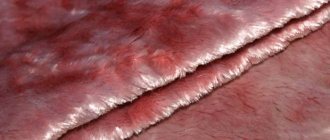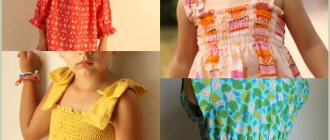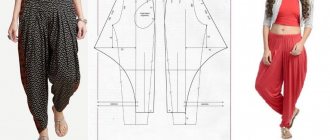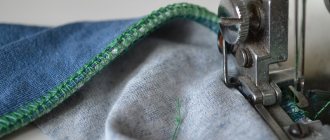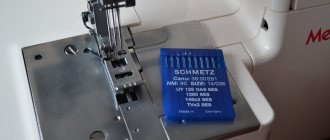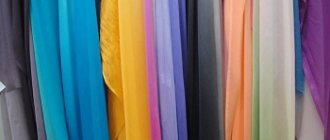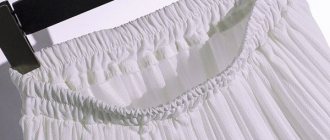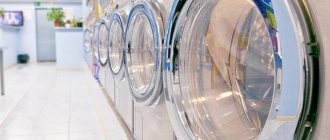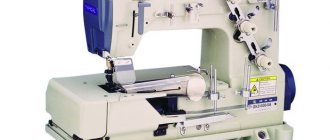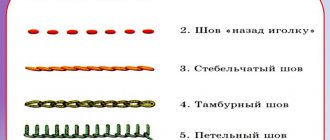Perhaps it is not an exaggeration to say that plush is a fabric with which every person is somehow familiar. Very pleasant to the touch, reminiscent of fur, it is often used to make soft toys, various interesting crafts, and fashionable clothes. Plush materials are pile materials, characterized by characteristic hairs on the surface. Thanks to their beautiful and very cozy texture, they are in demand in the modern textile and clothing industry.
What kind of fabric
The famous “plush skirt”, which was sung about in a simple pop song of the 80s of the last century about Ksyusha, oddly enough, is still fashionable and relevant today. True, the manufacturing technology has changed a little, but the pleasant-to-touch material has not been forgotten. To understand what kind of fabric this is and why we like it so much, let’s look into history.
A little historical background
So, outwardly, plush fabric resembles fur, and, in fact, it is, but only artificial. The material appeared in Russia a very long time ago: approximately in the middle of the 17th century, but it gained the greatest popularity in the 70s of the 19th century. He was also in demand in the USSR. The material was used to make cozy jackets, as well as original women's short fur coats, which had the cute name “buns”.
Unique textiles were used to cover furniture and decorate simple interiors. One of the characteristic positive features of the material is that the pile practically does not fall out or spill out. It can only wear out over time. This is why plush fabrics are so in demand in everyday life.
And yet, so that you can accurately imagine what fluffy canvases look like, we offer a detailed description.
Description
The fabric has a pleasant fleecy surface. The hairs are long, about a centimeter, sometimes even longer. The texture is very delicate, pleasant to the touch, reminiscent of natural fur. In English, plush is written as plush, and translated as “chic” or “luxurious.” Indeed, this textile looks very beautiful.
Modern industry produces many varieties of the described canvases. They differ in pile length, composition, design and manufacturing technology. One of the most common types is called plush velor, but there are many others, which we will discuss in more detail below.
Compound
Initially, plush fabrics were made mainly from cotton raw materials, but today the compositions can be varied. For example, cotton is often combined with viscose, silk, and synthetics (polyester). Sometimes wool and other types of textile raw materials may be used.
Much more interesting is the method of producing artificial fur. There are several known technologies thanks to which the pile is obtained:
- looped, or continuous - elongated loops are formed on the surface;
- split, reminiscent of familiar fur hairs;
- one-sided, or facial;
- double-sided, located both outside and inside.
Plush fabrics with cut pile look very similar to velvet. As a rule, cotton raw materials are used as the basis, and viscose or wool fibers are used for the weft.
Looped models resemble familiar terry towels. They are created on special knitting machines, so it is more logical to talk about knitted fabrics than about classic fabrics.
Section of pile weave fabric: a) – weft weave; b) – warp weave, two-sheet method; c) – warp weave, rod method
Single-sided materials are more popular than double-sided ones, but today you can buy both.
Types and their properties
As mentioned above, plush fabrics can be divided according to the composition and types of fibers, pile length, additional design, etc. In this case, the properties practically do not change. We have already talked about the different compositions above, but we haven’t talked about the texture. So, plush fabrics are:
- smooth - classic options with an even, long pile, identical over the entire surface of the canvas, are considered a type of furniture, as they are often used for upholstery;
- patterned - have a beautiful, embossed surface, which is created by alternating hairs of different lengths, look magical and are used in interior textiles, as well as in the production of fashionable clothes;
- embossed - the pile is laid in different directions, forming interesting patterns, the scope of application is the same as that of the previous group, sometimes such fabrics are called felted;
- shaped - similar to patterned, but differs in more complex, interesting patterns, sometimes obtained by cutting or pressing the pile.
Color solutions are not limited: both classic white plush and fabrics in familiar natural shades are produced. Original solutions are especially popular: pink material with a vintage effect, green, yellow, crimson, blue, cyan, purple and many others. The basis is bleached artificial plush, which is then painted in any shade. You can carry out a similar process at home.
Flaws
Of course, there are also small disadvantages that you need to be aware of. Firstly, the canvases are quite dense and heavy. Their specific gravity cannot be called small. Many people note that plush sheepskin coats put pressure on their shoulders, creating some discomfort when wearing them.
Secondly, these textiles are not easy to process. Despite the fact that the pile itself does not crumble, the base fibers often spread out, so only professionals who are well acquainted with the technology can sew from plush.
Thirdly, matter collects dust; it is not for nothing that such toys are popularly called “dust collectors”. It gets dirty easily, which is not very good from the point of view of practicality and hygiene, especially for children's rooms.
From felt
Felt is a very popular material now, from which you can sew almost anything. In addition to all its advantages, for example, brightness, high density, it also holds its shape, which is especially important in some cases. For example, when sewing toys for puppet theaters, it is simply irreplaceable. In addition, cut edges made of this material do not fray or crumble, and therefore do not require additional processing.
Large soft products are unlikely to be made from it, since the rather dense hard felt will not be very convenient to stuff. It is more suitable for small animals or finger theater puppets, where the ability to keep its shape is important.
Master class on how to make a felt cow without a sewing machine:
How to sew a felt kitten with your own hands:
Application area
Despite the shortcomings, the material is in demand in modern life. A plush blanket will give you special comfort and a feeling of security. It is soft and very warm. The same can be said about a plush blanket, under which it is so pleasant to warm up on winter evenings.
Fluffy fabrics are used to make pillowcases, bedspreads, and other textile products, including even napkins. Plush beautifully covers children's sofas and lies in soft folds on armchairs. Comfortable, soft envelopes are sewn from it for babies.
Plush is actively used for toys. As children, many of us had cute bears, bunnies, squirrels, and foxes with a nice artificial fur coat. As a rule, plush for toys is traditionally natural, natural colors. However, modern fashion is changing ideas. Today there are bright, fantasy, unusual animals - toys made of multi-colored plush.
But not only ready-made canvases are found in modern stores. Now the so-called plush yarn has become incredibly popular - thick, very soft and delicate to the touch. It is used for various purposes - for knitting clothes, bedspreads, and other unusual things. The peculiarity of designer products made from plush yarn is their volume and cute, cozy appearance. This is most noticeable in interior or children's toys. They simply captivate at first sight. This is probably where the undying popularity of plush products lies.
Cloth
Plush clothing also does not lose popularity, despite the huge selection of other textile materials. Different types of fabrics are used to sew such products: knitted plush, textured, regular, trendy minky in white colors and others. Moreover, things are made for both adults and children, including newborns.
These can be fashionable women's or children's home suits (there are also models for men), jackets, snoods, plush dresses and much more. The material is often used for lining. Today, comfortable, cozy and incredibly soft plush suits have risen to the peak of popularity, not only for kids, but also for adults.
How to sew fabric toys
It’s easy to sew textile toys with your own hands, both with and without patterns. Of the most affordable fabrics for sewing soft toys with your own hands, you can use the most familiar to us: cotton or knitwear. It is with them that you can start practicing sewing, since scraps or pieces of this material are found in almost every home. Using a sewing machine is much more convenient than doing it by hand, since making small, neat, invisible stitches is quite difficult. These fabrics are easy to wash, which is a good reason to choose them, considering that children have a habit of getting everything dirty.
At the same time, the knitwear is elastic, which helps to easily shape the shape of the future toy. A large number of colors gives greater freedom of creativity. Among the disadvantages, one can highlight its rather high price. Most often it is used for making dolls and educational toys.
Cotton is no less popular for its availability, low price, and variety of colors. However, it does not hold its shape well and does not stretch.
Before starting the process, it is recommended to wash and iron the selected fabric. This will make cutting and sewing more convenient, and the product will ultimately turn out smooth and neat.
Master class on sewing an owl from old jeans:
Several videos on how to make different fabric toys with your own hands:
Care
This is not to say that plush fabrics are undemanding to care for. On the contrary, if you want them to remain beautiful longer, you will have to follow some rules. Be sure to read the accompanying label carefully. This will help avoid possible troubles.
Plush should not be washed, especially in a washing machine. The most reasonable and correct decision is to use dry cleaning services. However, while washing is still permissible for some types of products, it is strictly prohibited for bunnies and bears. Once the toys are in the washing machine, their cute appearance will disappear. The “fur” will become tangled and the shape will be lost. Therefore, to the question whether it is possible to wash them, the answer is clear: it’s not worth it. Only dry brushing or dry cleaning will help here.
But plush can be easily painted at home. Special textile dyes or simple potassium permanganate are suitable for this. But again, we are talking only about canvases; it is better not to experiment with finished products. Numerous painting methods are described in detail on the Internet.
Plush fabrics will never lose their relevance due to their beautiful, spectacular appearance. They are loved by craftswomen and widely used in modern industry.
Dear readers of the Tkan.Club website, if you still have questions on this topic, we will be happy to answer them. Leave your reviews, comments, share stories if you have dealt with this material! Your life experience may be useful to other readers.
Soft fur toys
Fur is an excellent material for sewing yourself, because compared to other fabrics it has one important advantage - it is very easy to hide seams among the long hairs of fur. And even if they turned out imperfect, no one will notice. In addition, it is also not necessary to work out very small details on the pattern; very small “protrusions” will still be lost in this material. At the same time, the larger the finished product, the easier it is to work with patterns, since sewing small parts will require some pains, especially at the beginning of work.
Many needlewomen refuse fur because it tends to fray, leaving small hairs everywhere, causing irritation in the eyes of some. In addition, some skill in cutting will be required.
Instead of scissors, it is recommended to use a special tailor's knife or a sharp stationery knife. Cutting movements should be short, avoiding deep penetration of the tool into the fur, so as not to damage it.
This material also requires special care, since most types of fur will need to be washed very carefully, or not at all.
